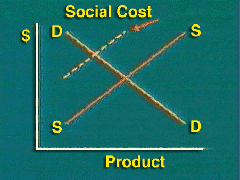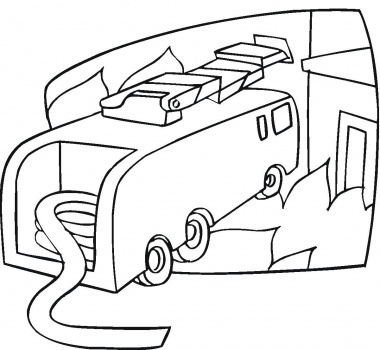ECONOMICS U$A
MARKET FAILURE
To show the market failures of capitalism as described by Karl Marx.
OBJECTIVES:
1. Classical economists did not have a satisfactory explanation for business cycles. They believed that the natural forces in the economy would always bring about an equilibrium between total supply and demand for goods in the economy.
2. Karl Marx provided a theory of mass unemployment in the context of
the built-in instability of capitalism.
3. Joseph Schumpeter explained business cycles as a natural
by-product of growth and innovation that was created
economic growth.
4. Market power is directly related to the producer’s
ability to control the total production of a product and
therefore keep prices and profits high.
5. At
one extreme monopolists can control total output and
therefore keep prices high – they are the price makers.
6. The more
concentrated market power is in a given market the higher
the likelihood that it is operating in a way which is
economically inefficient for society as a whole.
7.
The government can try to minimize or
control monopolies through regulation or breaking the
company up into smaller firms.
8. Market transactions do not always take all of the social benefits and costs of an economic activity into account. If private benefits and/or costs differ from social benefits and/or costs, an economic activity has "externalities." These externalities tend to disrupt economic efficiency.
9. Externalities can be internalized by tax and subsidy policies or by mandated control methods.
10.
Public goods will not be supplied in the proper amounts by the free-market mechanism.
11. It is difficult to determine how much a public good is worth to each individual because they may be able to benefit without having to
pay for them; this is the free rider problem.
12. Because the free-market mechanism will not supply public goods in the proper amounts, political processes are necessary to determine how much and how many public goods will be produced.
KEY ECONOMIC CONCEPTS:
government intervention in market failures: business cycles, asymetric information, public goods, externalities, and imperfect markets.

|
Contemporary Issues Exchange Rates In the three years after the launch of the euro (Europe’s new single currency) in January 1999, it lost close to a third of its value against the dollar. Many European leaders were embarrassed by the weakness of the fledgling currency and hoped that it would strengthen. They got their wish. Between January 2002 and the summer of 2003, the euro regained all the ground that it had lost against the dollar. However, the stronger currency was a mixed blessing. In 2003, many of the key European economies (including Germany) were in or close to being in a recession. A stronger euro only hurt them, by making European exports more expensive. Is a strong or a weak currency inherently good or bad? Under what circumstances might a strong or a weak currency be beneficial for an economy? |
For a complete transcript of this video program download TVpdf#28




| Business Cycles Karl Marx was the first economist to conceive of a self generated cycle in which good times produced eventual bad times and the bad times produced good times. During the times of economic depression, Marx’s followers were quick to point out the failure of Capitalism. But where Karl Marx had looked at the bust side of the cycle and forecast destruction, Joseph Schumpeter looked at the boom side and called it regeneration. Capitalism was by its nature intrinsically dynamic. The essence of Capitalism was to invent, innovate, to risk. Karl Marx saw economic fluctuations as increasing evidence of the failure of the system. Joseph Schumpeter saw these same business cycles as evidence of economic growth and the success of the system. Comment and Analysis by Richard Gill Both Karl Marx and Joseph Schumpeter differed from the classical economists who held that depressions were temporary and uncharacteristic. While Marx saw the laboring class suffering under the Capitalist system, Schumpeter saw that the laboring classes were actually the greatest beneficiaries of Capitalist mass production.
|
|
Monopoly The Sherman Act passed in 1890 was in response to the monopoly that John D. Rockefeller and his company Standard Oil had on the oil industry. Rockefeller did not take over the task of drilling for oil. Instead, he concentrated buying the oil that other men drilled--refining it and selling it. By 1869, he had the largest refinery in the country and a year later Standard Oil of Ohio was born. When competition squeezed profit margins, Rockefeller squeezed the competition. Willing competitors were bought. Unwilling competitors found themselves cut-off from railroads, pipelines, and credit. The Sherman Act made it illegal for any one firm to obtain a monopoly — that is to get complete control over the production of all the goods in one markets. Secondly, the Sherman Act made it illegal for firms to get together and agree on the way in which they would compete, for example, by setting prices or dividing markets or determining which customers they would deal with Despite the Sherman act it took awhile for the courts to finally break up Standard Oil. By 1911, competitors like Western Oil, like Gulf and Texaco had entered the refining business and had broken the Standard monopoly.That and the Sherman Anti-trust Act had ended the era of the big trusts. Comment and Analysis by Richard Gill The complaints against Standard Oil are based on the central economic critique of monopolies: they keep output too low, and their prices and profits are too high. Economists call these monopolies price-setters. On the other hand, firms whose prices are set in the market by supply and demand are called price-takers.  |
| Externalities Shortly after WWI, some entrepreneurs decide that there was money to be made in a rock called taconite, found in abundance near the Mesabi Iron Range. They called their venture the Reserve Mining Company. Basically the company built the tiny town of Silver Bay on the shores of Lake Superior in Minnesota. The refining process of the stone produces a vast amount of sandy residue called tailings. Reserve Mining found the cheapest place to dump these tailings was Lake Superior. In 1973, it was discovered that tailings might contain asbestos, a known carcinogen. Within a few weeks, much of the population of Duluth, 60 miles to the West had stopped drinking water. The case wound up in Federal Court. Environmentalists produced expert witnesses who said the tailings were dangerous. Reserve produced experts who said they were not… and hinted that they might be forced to shutdown the plant if denied access to the lake, which would result in economic hardship for the residents of Silver Bay. In 1977 the courts handed down its decision. Reserve agreed to keep the Silver Bay plant open and to build a tailings disposal sight seven miles inland from the lake at a cost of $400 Million. Comment and Analysis by Richard Gill The government has to get involved in cases like the Reserve Mining case because a market economy can’t handle them. When a business firm produces iron, or any other product, it has certain costs that it has to pay for. But it may impose other costs, in this case the pollution of Lake Superior, for which it does not have to pay. These costs are external to the firm and external to the supply-demand price system generally. This is why the government has to step in.  |
| Public Goods The great Mississippi flood of 1927 left 800,000 homeless as the swelling waters overran levies throughout the Tennessee River and into the Mississippi. Thousands of acres of farmland were damaged, turning Northern Louisiana into an inland sea, A technical solution, the building of dams, could have prevented the flood. In the absence of initiatives from the privates sector, some legislators felt that federal funds ought to be used. But they faced tough opposition on Capitol Hill. Dams not only control floods, but they can be used to generate large amounts of hydro-electric power… and that presented a threat of competition to the private utilities. In 1933 when Franklin Delano Roosevelt and a new administration, with an activist view of government, came into power, they created the Tennessee Valley Authority… the TVA. Some thought the government was now going too far. Along with the utilities, others who feared economic loss joined in the opposition. Coal miners feared the TVA’s generation of hydro-electric power would cut into the demand for coal and that thousands of coalminers would lose their jobs. The TVA argued that flood control was its primary goal and the revenues from energy sales only assisted in financing the dams. The opposition argued that the government had no right being in the power business. Within 5 years some 57 suits were brought against the TVA. Finally, in 1937, the legal issues were resolved. The U.S. District Court upheld the TVA, ruling that the projects were primarily for the improvements of navigation and flood control. Comment and Analysis by Richard Gill Even in a private market economy there are goods that virtually require government intervention since private enterprise will not or cannot produce them The TVA project of the 1930s provided what economists call a public good… a good that has to be provided collectively or not at all. I am speaking here of the flood control and navigation improvements made possible by the TVA dam. And the real problem with a public good like this is that it is impossible, or certainly extremely difficult, to charge any private consumer for the benefit he is receiving  |
